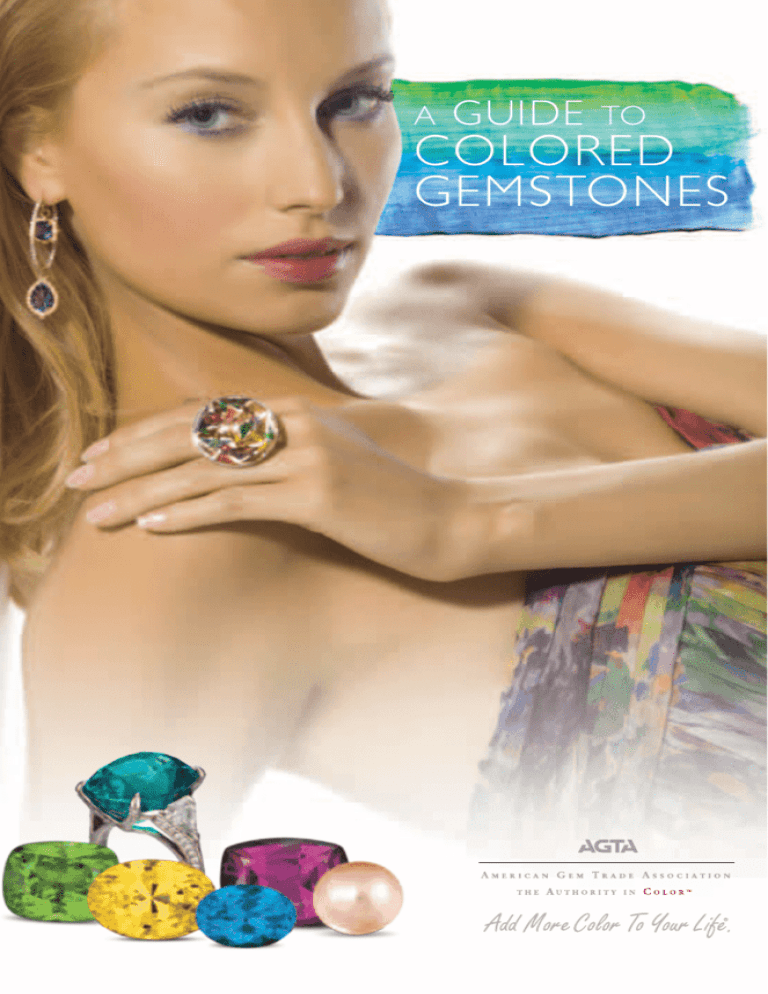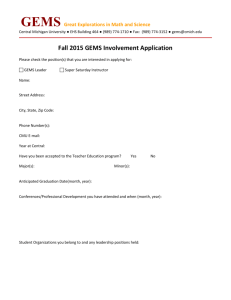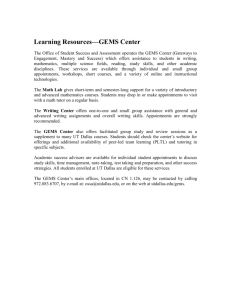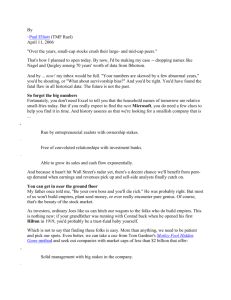
A
GUIDE
TO
COLORED
GEMSTONES
C o l o r , L i f e , G e m s a n d Yo u
C
olor is one of life’s defining elements. Whether it’s
reflected by nature’s seasonal transformations, fast-
paced changes in the current scene, or enduring personal
favorites for home and wardrobe, color can inspire, renew,
nurture, empower, communicate. Gems play delightful and
amazing – almost magical – games with color. From subtle
pastels and deep shades to bold bright primaries, gems run
through the spectrum and touch every nuance. They capture
elusive hues and hold them forever. Yet they change from
moment to moment, with light and setting and mood. Most of
all, gems put color close to you – to experience and enjoy for
yourself, or share and show to the world. This makes gems a
great way to add more color to your life.
AMERI C AN
G EM
T RADE
ASSO C IA T ION
C o l o r e d G e m s a n d J e w e l ry
I
n the gem kingdom, everything except diamond is considered
a colored gemstone – and that means endless possibilities. In
order to be classified as a gemstone, a naturally occurring mineral
(garnet) or organic material (pearl) must possess beauty, rarity,
a reasonable degree of durability and value. From amethyst and
aquamarine to zircon and zoisite, natural colored gems present a
mesmerizing selection of beauty. They offer a rainbow palette from
which to choose and come in myriads of enticing forms.
The jewelry in which gems sparkle and gleam extends the choices
to heights of imagination and delicious indulgence. Today’s
virtuoso designers use colored gems to create jewelry that’s
fashionable yet individual, chic yet timeless. Looks range from
classic to contemporary to cutting-edge. They’re daringly minimal,
unabashedly luxe, and everywhere in between.
As a result, colored gemstone jewelry can fit any taste, occasion, or
style to perfection. It can give a lifetime of enjoyment and become
an heirloom for future generations to treasure.
AMERI C AN
G EM
T RADE
ASSO C IA T ION
T o d ay ’ s v i r t u o s o
designers use
c o l o r e d g e m s to
c r e at e j e w e l ry
t h at ’ s f a s h i o n a b l e
yet individual,
chic yet timeless.
Dimensions of Appeal
G
ems and jewelry are beautiful, but that’s really just part of their
appeal. There’s fashion, self-expression, the charm of the old,
the excitement of the new, and much, much more as well.
In recent seasons the fashion world has rediscovered color and
the confident, feel-good femininity that goes with it. This has
made colored gemstone jewelry an essential component for every
wardrobe.
Beyond complementing apparel, the colors of gems conjure
emotions and convey meanings. The serenity of blue. The passion
of red. The vitality of green. Each gem color has its own energy,
spirit, and resonance.
Gems, themselves, embody Nature’s creative power. Over vast spans
of time, the same forces that shaped our planet compounded basic
elements into rare and captivating gems.
Gems also evoke the romance of faraway places. From where they’re
found – amid lofty mountains, in lush forests, beneath desert sands,
or bathed in ocean tides – gems carry exotic images, lingering
echoes, and alluring scents.
AMERI C AN
G EM
T RADE
ASSO C IA T ION
Gems are cloaked in rich traditions, too. Some have been prized
since the days of Cleopatra. For centuries, many were thought to
possess spiritual virtues or magical attributes. Royalty once imparted
a regal aura to gems. Today celebrities and pop icons add fresh
glamour to the age-old mystique.
Jewelry further enhances the artistry, imagery and messages of gems.
Be it a ring, necklace, bracelet, or earrings, every form plays a role
in adornment and expression. Designs draw inspiration, articulate
themes, and blend motifs from nature, history, world cultures, and
an exhilarating mix of here and now.
Of course, you decide which appeal dimensions are meaningful to you.
But the gems and jewelry you choose to wear can help you define your
individuality and celebrate your life – who you are, the milestones you
reach, the things you cherish and achieve along the way.
the fashion world has rediscovered color and
the confident, feel-good femininity that goes
with it. This has made colored gemstone jewelry
an essential component for every wardrobe.
AMERI C AN
G EM
T RADE
ASSO C IA T ION
C OLOR
CUT
V a l u e i s n ’ t a d e e p o r c o m p l e x m y s t e ry.
H o w e v e r , i t s i m p ly m a k e s s e n s e t o h a v e t h e
g u i da n c e o f a p ro f e s s i o n a l yo u t ru s t w h e n
yo u p u r c h a s e yo u r c o l o r e d g e m s to n e j e w e l ry.
C LARI T Y
C ARAT
WEI G H T
Making Informed Choices
I
t’s reasonable to expect lasting value and enjoyment when you
purchase gemstone jewelry, and there are a few things you should
understand in order to make sure you get what you want – and
deserve.
You can start by trusting your instincts. Sensory appeal is always
paramount. So, if a particular gem or jewelry design “speaks” to you,
by all means listen!
You can also use what you know about the 4Cs. The familiar
diamond value factors of color, cut, clarity, and carat weight apply to
colored gems as well. Each kind of gem must be judged by its own
potential, though.
Color – Every gem has a unique range. Generally speaking, the purest
and most vivid color a gem can have will also be the most expensive.
Cut – Next to color, this is the most important factor in beauty. Faceted
gemstones should have a pleasing shape with a lively display of color and light.
Clarity – If they don’t detract from appearance, clarity features are
accepted in most colored gems. In fact, they provide a benefit by proving
that the gem is natural.
Carat Weight – Most colored gems are available in a wide range of
sizes, but for some the selection is limited.
In addition to the 4Cs, gem values are influenced by natural rarity
and the economics of supply and demand. This explains why gems
that look similar in color and size can differ substantially in price.
The creativity and craftsmanship that go into fashioning gems and
making jewelry also affect the value of the finished product. Besides
being beautiful, an exquisite gem reflects the union of aesthetics,
science and technical mastery. Fine jewelry combines gems and
precious metal with talented design, skilled execution and attention
to even the smallest details.
Value isn’t a deep or complex mystery. However, it simply makes
sense to have the guidance of a professional you trust when you
purchase your colored gemstone jewelry.
AMERI C AN
G EM
T RADE
ASSO C IA T ION
ONE : C o l o r
ome gems come in a multitude of colors, while others have more
restricted palettes. Experts analyze all these chromatic options in terms
of three essential components: hue, tone, and saturation. Hue is the basic
color sensation – blue, red, green, and so forth, plus blends like purplish
red and violet-blue. Tone is a color’s lightness or darkness, and saturation
is its visual intensity.
Colors of pure hue, medium tone, and high saturation are generally most
valuable, but different kinds of gems have differing potentials in this
regard. For example, sapphire and tanzanite can reach a deeper blue than
aquamarine, topaz or zircon. Color ranges can overlap to some extent, so
different gems may have the same color. Each is valued according to its own
unique possibilities, however. Thus, the particular tint that’s considered
“best” for one gem might be “medium” for another.
In buying decisions, you need to be aware of color ranges and objective value
assessments, but it’s best to rely on your eyes and heart. Pure or mixed, light
or dark, vivid or muted – whichever color holds the most appeal for you is
the one to choose.
S
T WO : C U T
hoices in cut are almost as varied as for color – and they’re every bit
as intriguing. Transparent colored gems are most often faceted like
diamonds, in dozens of geometric shapes and styles. The ancient domed
form known as the cabochon is traditional for gems like jade, opal, and
turquoise. It helps to bring out the special optical effects seen in star gems
and cat’s-eyes, too. Today many kinds of gems are fashioned into carvings.
These range from classic cameos and natural motifs to designs that push the
edge of abstract expression.
Whatever the technique may be, cut is chiefly responsible for revealing a
gem’s beauty. Its contribution to appeal and value arises from the cutter’s
artistic creativity, technical skill and patient labor.
To judge the quality of cut, examine the gem as you hold it at arm’s length
and rock it gently back and forth. The overall form ought to be pleasing
C
AMERI C AN
G EM
T RADE
ASSO C IA T ION
and dynamically balanced. Color and light should dance throughout a faceted
gem, with no washed out “window” in the center or dead spots around the
edges. When you look close-up, details like facet shape need to be precise, with
polished surfaces appearing smooth and bright.
T HREE : C LARI T Y
ost kinds of colored gems may have internal characteristics – or inclusions
– that are possible to see without magnification. Many of these are simply
byproducts of the natural processes that create gems within the Earth. Among
the most common are tiny mineral crystals that became caught up in larger gem
crystals as they grew. As long as such inclusions aren’t prominent, they don’t
diminish a colored gem’s beauty or desirability, and have little effect on its value.
There are some exceptions to this rule, however. You can expect a few gems
to be “eye clean,” with only microscopic clarity features. This list includes
aquamarine, citrine, tanzanite and topaz. On the other hand, inclusions in
emerald and red tourmaline may be fairly obvious, but won’t have a major
impact unless they’re also unsightly.
It’s important to recognize that inclusions have a positive side, too. They
can prove that the gems in which they occur are natural – not synthetic or
imitation. Scientists study inclusions to learn the secrets of how gems form, and
when viewed under a microscope, some are strikingly beautiful in their own right.
M
FOUR : C a r a t W e i g h t
ike diamonds, most colored gems are weighed and priced by the carat. (One
carat equals 1/5 gram.) As with color, however, different kinds of gems have
differing weight potentials. A few rarely exceed 5 carats in high quality. Many
are readily available up to 15 or 20 carats, and some can be even larger.
L
For gems with limited weight ranges, per-carat prices usually climb steeply as the
carat weight goes up. For those with wider ranges, any increases tend to be more
gradual. A 3-carat ruby might have a per-carat price that’s three times higher
than a 1-carat ruby of the same quality. As a result, the larger gem would cost
nine times more than the smaller one. In contrast, a 5-carat amethyst is likely to
have about the same per-carat price as a 1-carat amethyst, so it will cost only five
times as much.
Besides reflecting the natural rarity of larger gems, per-carat price can serve as
an indication of other value factors. If two gems of the same kind and weight
have significantly different per-carat prices, there will be differences in color, cut,
or clarity, which you need to consider in a purchase decision.
AMERI C AN
G EM
T RADE
ASSO C IA T ION
Gemstone
Colors
red
pink
The following list gives you an idea of the diverse colors, or hues,
found among a number of different gemstones. Consider this
sampling of gemstones available within each color range.
Ruby, Garnet (including Almandite and Rhodolite),
Tourmaline, Sunstone, Spinel and Red Beryl.
Tourmaline, Spinel, Sapphire, Kunzite, Morganite, Topaz,
Garnet (Rhodolite), Pearl, Opal and Quartz.
purple
blue
Amethyst, Sapphire, Tanzanite, Spinel and Iolite.
Sapphire, Tanzanite, Tourmaline, Iolite, Spinel, Aquamarine,
Topaz, Zircon and Chalcedony.
green
Yellow &
orange
Emerald, Garnet (Tsavorite), Tourmaline, Peridot, Green Beryl,
Sapphire, Andalusite and Jade (Jadeite, Nephrite).
Citrine, Golden Beryl, Sapphire, Topaz, Tourmaline, Fire Opal,
Diamond, Zircon and Garnet (Spessartite, Malaya, Hessonite).
white
Pearl, Moonstone, Jade (Jadeite, Nephrite) and Chalcedony.
multicolor
Opal, Ametrine, Ammolite, Tourmaline
Add More Color to Your Life
™
www.addmorecolor toyourlife .com
3 0 3 0 LB J F reeway, Sui te #840, Dallas, Texas 75234
2 1 4 - 742-4367 fax 214-742-7334
800-972-1162
www.agta.org
All jewelr y images from AGTA Spectrum Awards Collection and AGTA Stock Photography Program.
Reproduction of this brochure is strictly prohibited. All content is the sole property of the AGTA.
AGTA © 2009. All rights reserved.







